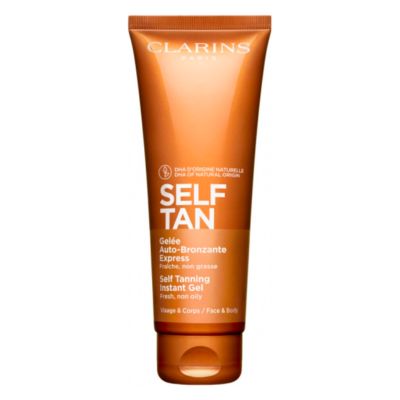Winkelwagen
U heeft geen artikelen in uw winkelwagen
Voor een natuurlijke en egale zongebruinde tint raden we de Collistar Magic Drops aan. Dit product komt als beste algemene keuze uit onze test, omdat het voor een natuurlijke kleur zorgt, makkelijk aan te brengen is op het gezicht en lang meegaat. Je hoeft slechts enkele druppels te gebruiken of te mengen met een dagcrème.
Een uitstekende keuze in een hogere prijsklasse is de Marc Inbane Natural Tanning Spray. Dit voedende product is geschikt voor alle huidtypen, ook voor als je gevoelige huid hebt en snel puistjes krijgt. Een andere hydraterende zelfbruiner met mooie resultaten is de Biodermal Sun Kissed Bodylotion.
hawaiian tropic sunless tan foam light/medium 200 ml
Ook in ons kikkerlandje kun je je op een eiland wanen met de tan foam van Hawaiian Tropic. Dit product heeft een ultralichte, sneldrogende formule die hydrateert en verzorgt, waardoor een vlekkeloze, streepvrije glans achterblijft. Verrijkt met aloë vera en vitamine E brengt de tropische geur van deze zelfbruiner je naar een tropisch eiland terwijl je een egaal en gebruind lichaam ontwikkelt. Met deze tanning mousse heb je geen parfum meer nodig. Voor een vlekkeloze en streepvrije bruining wordt aanbevolen om de huid schoon te maken en te exfoliëren, het schuim goed te schudden, aan te brengen met een handschoen of hand en gelijkmatig te verdelen in een cirkelvormige beweging. Voor een diepere tint kan een extra laag worden aangebracht. Het is belangrijk om de handen te wassen na gebruik en het schuim te laten drogen voordat je je aankleedt. Voor een langer aanhoudende, donkerdere tint kan het schuim tot 6 uur op de huid blijven zitten voor het douchen.

FEIT. Je vergroot het risico op blaren en verbranding door de laser. Dit komt doordat laserlicht reageert op de kleur van je haartjes. Als je huid donkerder is gemaakt door zelfbruiners, trekt dit extra licht van de laser aan. Hierdoor wordt er meer laserenergie geabsorbeerd door de opperhuid in plaats van in de basis van het haarzakje. Dit veroorzaakt een verhoogd risico op blaren en verbranding.
TIP. Aangezien het belangrijk is je zelfbruiningscrème gelijkmatig aan te brengen, neem je hier waarschijnlijk rustig de tijd voor. Bovendien laat je de zelfbruiner meestal ruimte tijd intrekken. Een uitgelezen kans om in de tussentijd je lichaam te checken op moedervlekken. Gebruik hiervoor de ABCDE-methode en vergeet plekjes tussen tenen en vingers of op je voetzolen niet. Toch de zon in? Lees mijn tips over zonnebrand insmeren.

Wat de beste zelfbruiner is? Ik heb geen voorkeur voor specifieke merken en denk dat je zelf kunt uitproberen wat werkt. Wel adviseer ik om altijd naar de ingrediënten en het percentage DHA te kijken. Hoe bleker de huid, hoe lager het percentage zou moeten zijn.
In zelfbruiners zit dihydroxyacetone (DHA), dit is een kunstmatige suiker. DHA reageert met de eiwitten in de bovenste laag van de huid, die bestaat uit dode huidcellen. Deze reactie resulteert in een bruine kleur.
Hoe vaak per week kun je zelfbruiner gebruiken?De meeste zelfbruiners kunnen naar eigen behoefte worden gebruikt voor het gewenste resultaat. Vaak is dit 1 tot 2 keer per week.
Dit verschilt per product en is afhankelijk van het gewenste resultaat. Vaak is dit 1 tot 2 keer per week.
Dit is afhankelijk van het product en het gewenste resultaat. Vaak wordt er geadviseerd om minimaal 1 tot 6 uur lang de zelfbruiner op de huid te laten zitten.
Je kunt de zelfbruiner van de huid verwijderen door de huid te wassen met lauw water en een reinigend product, zoals bijvoorbeeld een Douchecrème.
Hoe lang blijft een zelfbruiner zitten?Dit verschilt per product. Meestal blijft de kleur 5 tot 7 dagen zichtbaar.
Kun je zelfbruiner over een tattoo smeren?Ja, je kunt een zelfbruiner over een tattoo heen aanbrengen.
Kun je zelfbruiner op je gezicht smeren?Ja, je kunt ook voor het gezicht een zelfbruiner gebruiken. Controleer altijd op de verpakking van het product of dit wordt geadviseerd.
Kennelijk slaat er lichte paniek toe als onze benen weer bloot mogen. Hoe kun je het beste je benen ontharen? Ik deel tips voor mooie, gladde en vooral gezonde onderbenen.

De Collistar Magic Drops zorgen voor een natuurlijke en zonnige glow op je gezicht en decolleté.
Het product is zo ontwikkeld dat je met slechts enkele druppels het gewenste resultaat bereikt, waardoor een verpakking lang meegaat. We waren onder de indruk van het snelle resultaat! Mocht je de medium tint wat te donker vinden, mix je de druppels met een dagcrème voor een subtieler resultaat. Let op: de druppels zijn iets minder geschikt voor het hele lichaam en speciaal ontwikkeld voor je gezicht en decolleté.
Naast een bruine tint, zorgen de druppels ook voor hydratatie en gaan ze huidveroudering tegen. Een voorbeeld van zo’n ingrediënt is vitamine E. We vonden de resultaten subtiel en egaal zonder vlekken of oranje strepen. De geur viel ons mee, maar je ruikt het wel een beetje.
Kortom, een echte aanrader als je op zoek bent naar een hoogwaardige zelfbruiner voor je gezicht die voor snelle en natuurlijke resultaten zorgt.
De Marc Inbane Natural Tanning Spray zorgt voor een natuurlijke teint, bevat voedende ingrediënten en is geschikt voor alle huidtypen.


